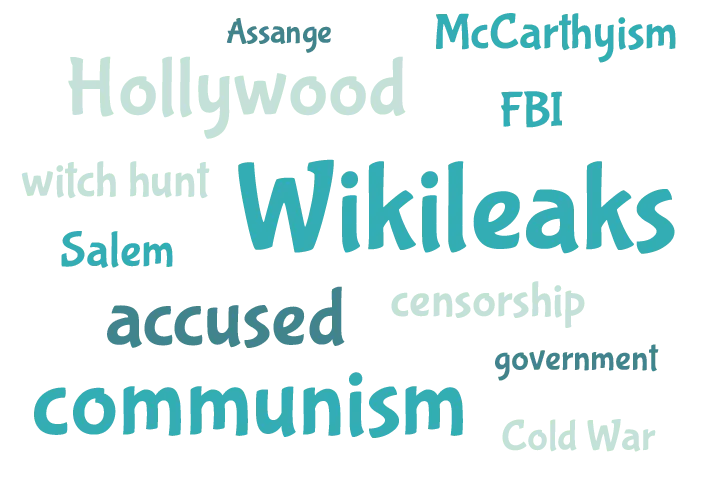Anglais Terminale
Rejoignez la communauté !
Co-construisez les ressources dont vous avez besoin et partagez votre expertise pédagogique.
Mes Pages
1. Identities and Exchanges
Ch. 1
The Canadian Tale
Ch. 2
Go Greek!
2. Private and Public Spheres
Ch. 3
Is It a Man’s World?
Ch. 4
The Roaring Twenties
3. Art and Power
Ch. 5
A Camera of Her Own
Ch. 6
A Never-Ending (Hi)story?
Ch. A
Conscious Art
4. Citizenship and Virtual Worlds
Ch. 7
To Tweet or Not to Tweet?
Ch. B
Digital Passports at Risk...
Ch. C
May I Borrow This?
5. Fiction and Realities
Ch. 8
Chivalry Isn’t Dead!
Ch. 9
It’s GoT to Be Shakespeare!
6. Scientific Innovations and Responsibility
Ch. 10
Breaking the Code
Ch. 11
Green Waves
Ch. D
To Infinity and Beyond!
Ch. num
Tech for the Future?
7. Diversity and Inclusion
Ch. 12
Multicultural New Zealand
Ch. 13
Black Lives Matter
8. Territory and Memory
Ch. 14
Lighting Up Africa
Ch. 15
American Vibes
Fiches Méthode
Précis
Précis culturel
Précis de communication
Précis phonologique
Précis grammatical
Verbes irréguliers
CECR et programme
Rabats & annexes
Révisions
Unit 6
Bac
Exam file
Préparation aux évaluations communes
Ressource affichée de l'autre côté.
Faites défiler pour voir la suite.
Faites défiler pour voir la suite.
Évaluations communes
1H30Ressource affichée de l'autre côté.
Faites défiler pour voir la suite.
Faites défiler pour voir la suite.
'Witch-hunt & modern day McCarthism': Comedian summoned to intel committee over Assange interview, RT, 2017.
Ressource affichée de l'autre côté.
Faites défiler pour voir la suite.
Faites défiler pour voir la suite.


Ressource affichée de l'autre côté.
Faites défiler pour voir la suite.
Faites défiler pour voir la suite.


Ressource affichée de l'autre côté.
Faites défiler pour voir la suite.
Faites défiler pour voir la suite.
Compréhension de l'oral Witch Hunt and Modern Day McCarthyism
1
Avant l'écoute Lisez le titre ci-dessus et regardez le nuage de mots.
a. Sur quoi peut porter cet enregistrement ? Faites trois hypothèses.
b. Trouvez cinq autres mots que vous pourriez entendre dans l'enregistrement.
2
Après l'écoute En rendant compte, en français, du , vous montrerez que vous avez compris les éléments suivants :
- Le thème principal du document ;
- À qui s'adresse le document ;
- Le déroulement des faits, la situation, les événements, les informations ;
- L'identité des personnes ou des personnages et, éventuellement, les liens entre elles / entre eux ;
- Les éventuels différents points de vue ;
- Les éventuels éléments implicites du document ;
- La fonction et la portée du document (relater, informer, convaincre, critiquer, dénoncer, etc.).
Ressource affichée de l'autre côté.
Faites défiler pour voir la suite.
Faites défiler pour voir la suite.
Compréhension de l'écrit
The media may be new, but the punitive messages and appetites remain the same. Today's tech simply provides new outlets for the worst behaviour.
Although the west's appetite for witch-hunting has long been sated, the urge to persecute has not, which explains why the idea remains so useful. Politicians and celebrities and journalists use the term “witch-hunt” all the time. In March this year the blogger Craig Charles Haley described “social media witch-hunts” as “witch-hunts on steroids”. Accusations go viral, globally, within hours, and “instead of having dozens of angry voices baying for your blood”, writes Haley, “you have tens of thousands”. Typically the accusers are cowardly, ignorant, offensive and openly misogynistic. When the historian Mary Beard appeared on BBC's Question Time, she received torrents of abuse from internet trolls, less about what she had said than about how she looks.
In the victimisation of public figures like Beard, we instantly recognise the witch-hunting paradigm: a mob pointing at an older woman, exposed in public and outspoken. But what, historically, are we referring to? Haley assumes we know. A witch-hunt was “the search for those people – usually solitary women – suspected of witchcraft, guided by panic, misinformation and misunderstanding”. Without pretence to a fair hearing, “communities would execute their suspects” on the thinnest proof.
Yet much of what we know, from folklore and fiction, is wrong. Robert Eggers' horror movie, The Witch, set in New England in 1630, examines a family in the wilderness, afraid of what lurks in the woods. Eggers gives us a real witch, fleetingly glimpsed yet malevolently near. However, most real suspected witches were not isolated figures hounded by their communities. They were integrated and proximate, and all the more scary for that. Accusations involved personal relationships and intense emotions rather than random scapegoating. [...]
And how do things look today? Misogyny thrives. A recently published study by the thinktank Demos revealed that in one three-week period in the UK, the words “slut” and “whore” had been directed at 6,500 unique Twitter users in 10,000 tweets. It's striking that half these cyber-bullies were women. This is alarming, but we shouldn't confuse new media with old messages. Most lawsuits for defamation, hidden in the archives, involve sexual slander using words like “whore” and “witch”, and often both plaintiff and defendant were female. The big difference is that these enemies knew each other.
Perhaps we shouldn't linger too long on the perpetrators. What about the victims? In some witch-hunts every suspect was a woman, and overall the proportion was 80%. The Bible taught that women were “the weaker vessel”, and therefore more vulnerable to diabolic temptation. Physicians saw female bodies as leaky, corrupt, rebellious.
And just as then so, too, are most victims of cyber-bullying female. Perhaps, as with so many prejudices we think we've abandoned, some of this is hardwired into us. According to Alex Krasodomski-Jones, a researcher at Demos, the digital age creates “new battlegrounds of the worst aspects of human behaviour”. But it's this human essence that should worry us, as much as the means by which it's manifested.
Although the west's appetite for witch-hunting has long been sated, the urge to persecute has not, which explains why the idea remains so useful. Politicians and celebrities and journalists use the term “witch-hunt” all the time. In March this year the blogger Craig Charles Haley described “social media witch-hunts” as “witch-hunts on steroids”. Accusations go viral, globally, within hours, and “instead of having dozens of angry voices baying for your blood”, writes Haley, “you have tens of thousands”. Typically the accusers are cowardly, ignorant, offensive and openly misogynistic. When the historian Mary Beard appeared on BBC's Question Time, she received torrents of abuse from internet trolls, less about what she had said than about how she looks.
In the victimisation of public figures like Beard, we instantly recognise the witch-hunting paradigm: a mob pointing at an older woman, exposed in public and outspoken. But what, historically, are we referring to? Haley assumes we know. A witch-hunt was “the search for those people – usually solitary women – suspected of witchcraft, guided by panic, misinformation and misunderstanding”. Without pretence to a fair hearing, “communities would execute their suspects” on the thinnest proof.
Yet much of what we know, from folklore and fiction, is wrong. Robert Eggers' horror movie, The Witch, set in New England in 1630, examines a family in the wilderness, afraid of what lurks in the woods. Eggers gives us a real witch, fleetingly glimpsed yet malevolently near. However, most real suspected witches were not isolated figures hounded by their communities. They were integrated and proximate, and all the more scary for that. Accusations involved personal relationships and intense emotions rather than random scapegoating. [...]
And how do things look today? Misogyny thrives. A recently published study by the thinktank Demos revealed that in one three-week period in the UK, the words “slut” and “whore” had been directed at 6,500 unique Twitter users in 10,000 tweets. It's striking that half these cyber-bullies were women. This is alarming, but we shouldn't confuse new media with old messages. Most lawsuits for defamation, hidden in the archives, involve sexual slander using words like “whore” and “witch”, and often both plaintiff and defendant were female. The big difference is that these enemies knew each other.
Perhaps we shouldn't linger too long on the perpetrators. What about the victims? In some witch-hunts every suspect was a woman, and overall the proportion was 80%. The Bible taught that women were “the weaker vessel”, and therefore more vulnerable to diabolic temptation. Physicians saw female bodies as leaky, corrupt, rebellious.
And just as then so, too, are most victims of cyber-bullying female. Perhaps, as with so many prejudices we think we've abandoned, some of this is hardwired into us. According to Alex Krasodomski-Jones, a researcher at Demos, the digital age creates “new battlegrounds of the worst aspects of human behaviour”. But it's this human essence that should worry us, as much as the means by which it's manifested.
Social media witch-hunts are no different to the old kind – just bigger
Ressource affichée de l'autre côté.
Faites défiler pour voir la suite.
Faites défiler pour voir la suite.
Questions
a) Read the headline and imagine what the text is about.
b) Pick out words showing that social media witch hunts are a big issue / problem.
c) Pick out words showing that comments are frequently sexist.
d) What are the common points between witch hunts in the past and nowadays?
e) What is striking about the gender of online bullies?
f) What image of women was given by The Bible?
g) How does Alex Krasodomski-Jones feel about social media?
b) Pick out words showing that social media witch hunts are a big issue / problem.
c) Pick out words showing that comments are frequently sexist.
d) What are the common points between witch hunts in the past and nowadays?
e) What is striking about the gender of online bullies?
f) What image of women was given by The Bible?
g) How does Alex Krasodomski-Jones feel about social media?
Ressource affichée de l'autre côté.
Faites défiler pour voir la suite.
Faites défiler pour voir la suite.
Expression écrite
Choisissez un sujet et répondez-y en anglais en 120 mots minimum.
You have just read this article and talk about it with a friend. Imagine your conversation.
To what extent can you say that witch hunts are part of American history?
Sujet A -
You have just read this article and talk about it with a friend. Imagine your conversation.
Sujet B - et
To what extent can you say that witch hunts are part of American history?
SUJET C :
To you, is Randy Credico the victim of a modern witch hunt? Share your reaction to the video and support your opinion with examples.Ressource affichée de l'autre côté.
Faites défiler pour voir la suite.
Faites défiler pour voir la suite.
- Définissez les caractéristiques d'une chasse aux sorcières. Expliquez en quoi cet exemple en est une.
- Justifiez vos arguments et donnez des exemples.
- Utilisez un vocabulaire varié pour exprimer votre opinion et vos sentiments.
Une erreur sur la page ? Une idée à proposer ?
Nos manuels sont collaboratifs, n'hésitez pas à nous en faire part.
j'ai une idée !
Oups, une coquille
